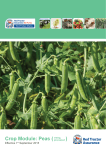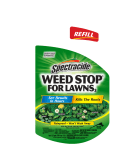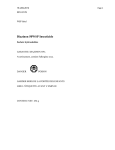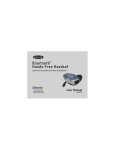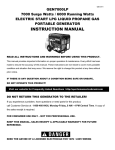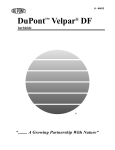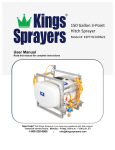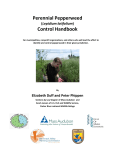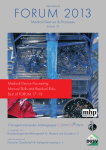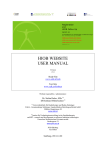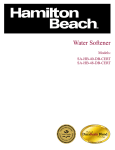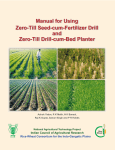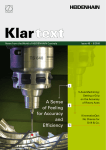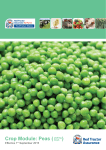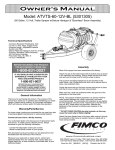Download Herbicide Application Handbook
Transcript
1 Table I of Contents Introduction 1 Product Information 4 Proper Handling Procedures 15 Calibration Procedures 18 Proper Spraying Procedures 30 Disposal and Spill Procedures 46 Stewardship 53 2 Introduction The Monsanto Herbicide Application Handbook is your guide to proper use of Monsanto herbicides for the Industrial, Turf & Ornamental (IT&O) industry. The information in this book applies to the use of Monsanto’s IT&O products: Roundup PROMAX®, Roundup PRO®, AquaMaster®, QuikPRO®, Roundup PRO® Concentrate, Outrider®, Campaign®, and Certainty®. These herbicides are designed to control weeds that are problems in turf and ornamental sites—like golf courses, nurseries, and lawns—as well as industrial sites, such as roadsides, canals, parks, schools, and right-of-ways. Monsanto herbicides are manufactured in a fashion that has earned high marks on the environmental stewardship front. They help restore wildlife habitats, rid areas of noxious weeds, and serve as valuable tools for integrated pest management. The IT&O industry is vital to beautifying and protecting our rural and urban communities, keeping our water systems safe and in a natural state of balance, and helping our infrastructure systems— roads, parks, and landscapes, for example—function successfully. Monsanto helps make your job easier by providing support to assist with the operational demands of IT&O. We encourage you to keep this handbook close and reference its contents whenever you have questions about proper Monsanto product use. Together, we can preserve the nation’s infrastructure, environment and natural resources. Monsanto herbicide technology can help assure your success for years to come. 3 PRODUCT I INFORMATION 4 Monsanto I Product Information Monsanto’s herbicide products globally include more than 90 glyphosate-based herbicides, such as the Roundup-branded agricultural herbicides and Roundup branded industrial, turf and ornamental products. Some of the sites where these products can be used to control weeds are roadsides, parks, schools, golf courses and lawns. Roundup-brand herbicides are valuable tools for integrated pest management programs and can be used to restore habitat and wildlife food production areas that have been taken over by noxious weeds like johnsongrass, poison ivy, Canada thistle, musk thistle and yellow starthistle, among many other uses. 5 Roundup PROMAX® I Herbicide Sample Specifications: 1. Monsanto Roundup PROMAX herbicide. 2. Roundup PROMAX by Monsanto, No Substitutions. 3. Roundup PROMAX by Monsanto, EPA Registration Number 524-579, No Substitutions. 4. Roundup PROMAX herbicide contains 48.7% glyphosate and surfactant and requires no additional adjuvant; the glyphosate/adjuvant formulation has a Class 3 “CAUTION” signal word and a “30 Minute Rainfast Warranty.” 5. 48.7% glyphosate and surfactant and requires no additional adjuvant; the glyphosate/adjuvant formulation has a Class 3 “CAUTION” signal word. 6. 48.7% glyphosate; “CAUTION” signal word; EPA Registration Number 524-579. 7. 48.7% glyphosate; “CAUTION” signal word; English and Spanish label. Other custom specifications can be created to meet the needs of your agencies bid policies. Packaging and Weights: 1. 1.67-gallon plastic jug: 2 jugs per case, 45 cases per pallet, weighing 2,006 pounds per pallet. 2. 30-gallon returnable plastic drum: 4 drums per pallet. One drum weighs 356.36 pounds, one pallet weighs 1,464.54 pounds per pallet. Roundup PROMAX (liquid) Number: 524-351 Product Description: Roundup PROMAX liquid is a postemergence, systemic herbicide with no residual activity. It gives broad spectrum control of many annual weeds, perennial weeds, woody brush, and trees. It is formulated as a water-soluble liquid containing surfactant, and no additional surfactant is needed or recommended. Roundup PROMAX liquid has a Class 3 “CAUTION” signal word. The Roundup PROMAX label is written in both English and Spanish. The surfactant in Roundup PROMAX is the proprietary PROformance system. Thus, there are no other products that are identical to Monsanto’s Roundup 6 PROMAX. Roundup PRO® I Herbicide (liquid) EPA Registration Number: 524-475 Product Description: Roundup PRO liquid is a postemergence, systemic herbicide with no soil residual activity. It gives broad-spectrum control of many annual weeds, perennial weeds, woody brush and trees. It is formulated as a water soluble liquid containing surfactant and no additional surfactant is needed or recommended. Roundup PRO liquid has a Class 3 “CAUTION” signal word. The Roundup PRO label is written in both English and Spanish. The surfactant in Roundup PRO is the proprietary PROformance system. Thus, there are no other products that are identical to Monsanto’s Roundup PRO. Sample Specifications: 1. Monsanto Roundup PRO Herbicide. 2. Roundup PRO by Monsanto, No Substitutions. 3. Roundup PRO by Monsanto, EPA Registration Number 524-475, No Substitutions. 4. Roundup PRO herbicide contains 41% glyphosate and surfactant and requires no additional adjuvant; the glyphosate/adjuvant formulation has a Class 3 “CAUTION” signal word and a “1 Hour Rainfastness” guarantee. 5. 41% glyphosate and surfactant and requires no additional adjuvant; the glyphosate/adjuvant formulation has a Class 3 “CAUTION” signal word. 6. 41% glyphosate; “CAUTION” signal word; EPA Registration Number 524-475. 7. 41% glyphosate, “CAUTION” signal word. English and Spanish label. Other custom specifications can be created to meet the needs of your agencies bid policies. Packaging and Weights: 1. 2.5-gallon plastic jug: 2 jugs per case, 48 cases per pallet, weighing 2,633 pounds per pallet. 2. 30-gallon returnable plastic drum: 4 drums per pallet, weighing 1,278 pounds per pallet. 3. 150-gallon returnable shuttle: 1x150 gallons weighing 1,631 pounds. 7 AquaMaster® I Emerged Aquatic Weed and Brush Herbicide : Sample Specifications: 1. AquaMaster Herbicide by Monsanto, 53.8% glyphosate, Class 3 “CAUTION” signal word, full aquatic label with no use restrictions. 2. AquaMaster Herbicide by Monsanto, EPA Registration Number 524-343. 3. AquaMaster Herbicide by Monsanto, EPA Registration Number 524-343, No Substitutions. 4. 53.8% Glyphosate, registered for aquatic use, no use restrictions on treated water, “CAUTION” signal word, a Service and Performance Guarantee to be made available by Monsanto. Packaging and Weights: 1. 2.5-gallon plastic jug: 2 jugs per case, 48 cases per pallet, 2,693 pounds per pallet. 2. 30-gallon returnable plastic drum: 4 drums per pallet, 1,315 pounds per pallet. 3. 150-gallon returnable shuttle: 1,682 pounds per shuttle. Shuttles do not arrive on pallets. EPA Registration Number: 524-343 Active Ingredient: Glyphosate Other Ingredients 53.8% 46.2% 100.0% Product Description: AquaMaster Emerged Aquatic Weed and Brush Herbicide is a water soluble liquid containing 53.8% glyphosate in the form of its isopropylamine salt, which mixes readily with water and nonionic surfactant to be used for the control and destruction of many herbaceous and woody plants. When used according to label directions, there are no use restrictions on water treated with AquaMaster Herbicide. 8 QuikPRO® Herbicide I Powered by Roundup Technology EPA Registration Number: 524-535 Product Description: QuikPRO is a postemergence, Systemic herbicide with no soil residual activity. It is generally non-selective and gives broad-spectrum control of many annual weeds, perennial weeds, woody brush and trees. It is formulated as a water-soluble granule containing 73.3% glyphosate in the form of its ammonium salt, 2.9% diquat dibromide, 23.8% other ingredients and no additional surfactant is needed or recommended. It may be applied through most standard sprayers after dissolution and thorough mixing with water, according to label instructions. Sample Specifications: 1. Monsanto QuikPRO Herbicide. 2. QuikPRO by Monsanto, No Substitutions. 3. QuikPRO by Monsanto, EPA Registration Number 524-535, No Substitutions. 4. QuikPRO Herbicide is a water soluble granule formulation and contains 73.3% glyphosate, 2.9% diquat dibromide and surfactant and requires no additional surfactant; the formulation has a “CAUTION” signal word and a “1 Hour Rainfastness” guarantee. Product package has a built-in measuring cap. English and Spanish label and Material Safety Data Sheet. 5. 73.3% glyphosate, 2.9% diquat dibromide and surfactant and requires no additional surfactant; the formulation has a “CAUTION” signal word. English and Spanish label and Material Safety Data Sheet. 6. 73.3% glyphosate, 2.9% diquat dibromide, “CAUTION” signal word, EPA Registration Number 524-535. Packaging and Weights: 1. 6.8-pound plastic jug: 4 jugs per case, 18 cases on a pallet. One pallet weighs 490 pounds. 2. 1.5-ounce packet: 5 packets in a box, 6 boxes in a case, 102 boxes on a pallet, one pallet weighs 527 pounds or 5,270 ounces. 9 Roundup PRO® I Concentrate Herbicide Sample Specifications: 1. Monsanto Roundup PRO Concentrate. 2. Roundup PRO Concentrate by Monsanto, No Substitutions. 3. Roundup PRO Concentrate by Monsanto, EPA Registration Number 524-529. 4. The herbicide Roundup PRO Concentrate contains 50.2% glyphosate in the form of its isopropylamine salt and the proprietary PROformance surfactant technology. The glyphosate/surfactant formulation has a Class 3 “CAUTION” signal word. 5. 50.2% glyphosate; “CAUTION” signal word; EPA Registration Number 524-529. 6. 50.2% glyphosate, “CAUTION” signal word. English and Spanish label and MSDS. EPA Registration Number 524-529. Packaging and Weights: 1. 2.5-gallon plastic jug: 2 jugs per case, 48 cases per pallet, weighing 2,663 pounds per pallet. 2. 30-gallon returnable plastic drum: 4 drums per pallet, weighing 1,278 pounds per pallet. 3. Non Key-Lock 150-gallon returnable/refillable shuttle: available in CA, AZ; no pump included: 1 x 150 gallons weighs 1,670 pounds 4. 15-, 30-, and 150-gallon returnable/refillable bulk containers: available through select dealers with authorized repackaging contracts. EPA Registration Number: 524-529 Product Description: Roundup PRO Concentrate is a complete broadspectrum Postemergence herbicide with a formulation containing 50.2% of the active ingredientglyphosate in the form of its isopropylamine salt. Site and use recommendations include cut stumps, general noncrop areas and industrial sites, habitat management, injection and frill (woody brush and trees), ornamental and plant nurseries, sod farms, Christmas trees, railroads and roadsides. Roundup PRO Concentrate has a Class 3 “CAUTION” signal word, and the Material Safety Data Sheet is printed in both English and Spanish. It is formulated as a watersoluble liquid Containing the proprietary PROformance surfactant technology. No other product contains Roundup PRO Concentrate’s surfactant technology. 10 Outrider® I Herbicide Outrider EPA Registration Number: 524-500 Product Description: Outrider Herbicide is a preemergence and postemergence, systemic herbicide for control of many annual and perennial broadleaf and grass weeds on noncrop sites, including unimproved bermudagrass and bahiagrass. It is formulated as a water dispersible granule (WDG). Outrider is 75% Sulfosulfuron and 25% other ingredients. It has a Class 3 “CAUTION” signal word. Sample Specifications: 1. Outrider Herbicide, 75% Sulfosulfuron, 25% inerts, Class 3 “CAUTION” signal word. 2. Outrider Herbicide by Monsanto, No Substitutions. 3. Outrider Herbicide, EPA Registration Number 524-500. 4. Outrider Herbicide. Packaging: 20-ounce bottle: 10 bottles per case = 200 ounces. 11 Campaign ® I Herbicide Sample Specifications: 1. Campaign Herbicide by Monsanto. 2. Campaign. Active Ingredients: glyphosate as the isopropylamine salt - 12.9%, 2,4-D as the isopropylamine salt - 20.6%. inert ingredients 66.5%. Packaging and Weights: 1. 2.5-gallon plastic jug: 2 jugs per case, 48 cases per pallet, weighing 2,544 pounds per pallet. Campaign EPA Registration Number: 524-351 Active Ingredients: Glyphosate, N-(phosphonomethyl) glycine in the form of its isopropylamine salt 12.9% 2,4-D,2,4dichlorophenoxyacetic acid, in the form of its isopropylamine salt Other Ingredients 20.6% 66.5% 100.0% Product Description: Campaign is a postemergence herbicide for control or suppression of emerged weeds. “DANGER” signal word. This product is recommended for use on weeds growing in areas such as airports, ditchbanks, dry canals, dry ditches, golf courses, highway rights-of- way, industrial plant sites, parking areas, parks, residential lawns, rangeland, roadsides, schools, storage areas, other public areas, and similar industrial or noncrop sites. 12 Certainty EPA Registration Number: 524-534 Product Description: This product is a postemergence, systemic herbicide with limited soil residual activity. It provides postemergence control of many annual and perennial sedges, grass and broadleaf weeds on highly managed turf, sod farms and native grass sites. It is a selective herbicide that can be used over the top of many perennial warm season and selected cool-season turfgrasses. The product is formulated as a water dispersible granule (WDG). Certainty is 75% sulfosulfuron and 25% other ingredients. It has a Class 3 “CAUTION” signal word. Certainty ® Turf I Herbicide Sample Specifications: 1. Certainty Herbicide, 75% sulfosulfuron, 25% inerts, Class 3 “CAUTION” signal word. 2. Certainty Herbicide by Monsanto, no substitutions. 3. Certainty Herbicide, EPA Registration Number 524- 534. 4. Certainty Herbicide. Packaging: 1.25 ounce bottle: 10 bottles per tray, 10 trays per case = 100 bottles per case, 25 cases per pallet. 13 Monsanto Industrial Turf I and Ornamental Web Site The Monsanto IT&O web site provides beneficial information on our Industrial, Turf & Ornamental product line in an easy-to-use format. To learn more about Monsanto’s herbicide products, what happens to a Monsanto herbicide product after it enters the environment, ecological effects, and health and safety information, review our environmental fact sheets. Also, to access and print product labels and MSDS sheets for Roundup PROMAX…. Also, to access and print product labels and MSDS sheets on Roundup PROMAX, Roundup PRO, AquaMaster, QuikPRO, Roundup PRO Concentrate, Outrider, Campaign, and Certainty, visit Monsanto’s web site today: www.monsanto.com/ito. 14 PROPER I HANDLING P ROCEDURES 15 Proper Handling I Procedures General Pesticide Handling Guidelines • Always read and follow pesticide label instructions. It is against the law to use a herbicide in any manner not specifically listed on the label or contrary to label instructions and requirements. • Always wear the protective clothing specified on the manufacturer’s label. Use of protective clothing should be in compliance with federal, local and state laws. • Handle pesticide containers carefully to prevent accidental ruptures or spills. Pesticide containers should never be dropped or thrown. Be aware of proper cleanup procedures in case of an accident. • Open pesticide containers carefully to prevent spills and make resealing easier. • Always measure pesticides carefully. Pesticides should only be used as directed on the product label. • Measure and pour pesticides below eye level to prevent spills or splashes. • Never spray pesticides in a manner that creates drift. 16 General Herbicide I Handling Guidelines continued • Always read and follow pesticide label instructions. It is against the law to use a herbicide in any manner not specifically listed on the label or contrary to label instructions and requirements. • Wear protective eyewear, including goggles, shields or safety glasses as required by the product label. • Wear gloves made of rubber or another material that will prevent contact between your skin and the herbicide solution. • In most cases, wear your sleeves over the outside of your gloves. Shirtsleeves should only be tucked inside gloves when your arms are raised during spraying. • Wear a long-sleeved shirt and long pants to protect your skin. On hot summer days, lightweight material or lightweight coveralls are preferable. • Wear protective clothing until spraying is complete and herbicides are put away. 17 CALIBRATION I PROCEDURES 18 Calibration I Procedures Factors Influencing Calibration There are four factors that determine the volume of spray applied: • Nozzle orifice size (controls gallons per minute/GPM) • Ground speed • Nozzle spacing or spray width (predetermined adjustments) • Pressure at the nozzle Nozzle size and ground speed are usually the factors to change or vary when large adjustments in spray volume are required for application. Nozzle spacing or spray width and nozzle pressure are the factors to consider for smaller adjustments. NOTE: To double the spray volume, the pressure must increase by a factor of four. Ground speed is usually the best way to adjust application rates. Herbicides must be applied at uniform, specified rates for effective, economical results. Proper application requires proper sprayer calibration, especially when using multiple nozzle booms, fixed nozzles and off-center nozzles. All of these sprayer operations are sensitive to uniform distribution widths, speeds and pressures. Handgun calibration is not generally practical or necessary where application rates are given in pounds or gallons of herbicide per gallons of water, and herbicides are sprayed until foliage is wet. Rather, the amount applied depends upon density of foliage or stems. For example, denser brush or trees would require a more thorough wetting. 19 Calibration I Checklist • First, rinse tank and fill with clean water. • Clean all nozzles and screens. Check nozzles for proper spraying and desired pattern and size. Be sure all nozzles of like size are discharging equal amounts of liquid. • Run sprayer, and flush all hoses and booms. • Check for leaks throughout the system. • With nozzles operating, adjust the engine speed or regulator to obtain desired pressure. • Calibrate sprayer under field conditions. • Watch for clogged nozzles and varying output among nozzles. • Make accurate measurements of distances, widths and volumes. • Recheck calculations to confirm your results. • Check uniformity and nozzle overlap by operating sprayer over paved surface. 20 Methods I of Calibration The Measured Distance Method The Measured Distant Method is used when making boom applications, generally in areas with wide rights-of-way or slopes that cannot be reached with boomless equipment. 1. Prepare sprayer as described in the “Calibration Checklist” (page 22). Change as necessary for desired output. 2. Consult your equipment catalog for proper nozzle size based on pressure desired. Set the desired pressure. Spray clean water through nozzles and collect output for 1 minute to check that each individual nozzle does not vary significantly from average or manufacturer’s specifications. Replace nozzles that show a significant variance in output from average or manufacturer’s specifications. NOTE: Lower pressure reduces fine droplets and spray mist. 3. Determine the effective swath width in feet. 4. Determine gallons per acre (GPA) of spray solution desired based on the equipment and product used. Consult literature provided by your equipment manufacturer. 5. Calculate the distance the sprayer must travel to cover one acre. 43,560 sq. ft./acre = Distance sprayer must travel Effective spray width in feet to spray one acre 6. Fill tank with clean water. Operate sprayer over the distance calculated in Step 5, using normal operating speed and pressure. Determine the amount of water sprayed by measuring the amount of water needed to refill the spray tank. 7. If the amount of water needed to refill the tank does not equal the GPA of spray solution desired (Step 4), repeat Step 6. Adjust speed or change nozzles until the predetermined output is obtained. 8. When the proper calibration has been obtained, repeat the procedure again to double-check the results. 9. Divide the capacity of your sprayer by the GPA of spray solution (Step 4) to provide the number of acres that can be sprayed when your spray tank is full. 10. Multiply the acreage capacity of your truck (Step 9) by the amount of each herbicide required per acre to determine the amount of each product to add to the tank. 21 Measured Distance Method I Calibration Worksheet Put your numbers into equations as indicated and calculate your results: 1. Tank capacity in gallons ÷ Sprayer output in GPA at desired PSI = Spray tank acreage capacity 2. Spray tank acreage capacity x Desired rate = Amount of product of herbicide per acre to add per tank Example: Desired application rate = 1.6 qts Roundup PRO Concentrate/acre Sprayer output at 30 PSI = 25 GPA (Step 6) 1. 1,000 gallon tank capacity ÷ 25 GPA = 40 acres spray tank capacity 2. 40 acres/tank x 1.6 qts (desired rate) = 64 qts. Roundup PRO Concentrate per tank GPA = Gallons Per Acre GPM = Gallons Per Minute MPH = Miles Per Hour PSI = Pounds Per Square Inch SW = Swath Width 22 Boomless Equipment I Calibration 1. If necessary, check ground speed using the formula: Distance (in feet) traveled in 1 minute 88 (constant factor) = MPH NOTE: Ground speed can be predetermined, but the speed-measuring method should be accurate. 2. Determine your GPM by collecting from all nozzles in each bank. Use a 1/2-inch clear plastic hose inserted snugly over each nozzle, and collect volume in a large calibration bucket for 30 seconds at desired pressure. Multiply the total gallons collected by 2 to arrive at the GPM. Gallons collected x 2 in 30 seconds = GPM 3. Compute the acres sprayed per minute using the formula: 2.02 (constant factor) x SW (in feet) x MPH 1,000 (constant factor) = acres/minute 4. Use the results of Step 2 and Step 3 in the formula below: GPM acres/minute = GPA NOTE: All banks should be close to the same GPM rate (Step 2). Periodically collect the flow to see if it is still around the same GPM benchmark you set (typically around 5 GPM). As long as speed, swath width and pressure remain constant, the GPA will remain accurate. 23 Boomless Equipment I Calibration Worksheet Put your numbers into the parentheses( ) as indicated and calculate your results: 1. (Distance [in feet] traveled in 1 minute) 88 (constant factor) = MPH 2. (Gallons collected in 30 seconds) x 2 = GPM 3. 2.02 (constant factor) x (Swath width in feet) x (MPH) = 1,000 (constant factor) ( ) = acres/minute 1,000 4. (GPM) = (acres/minute) GPA Example: 1. 1,056 ft (Distance traveled in 1 minute) 88 (constant factor) 2. = 12 MPH 2.5 gal. collected in 30 seconds x 2 = 5 GPM 3. 2.02 (constant factor) x 9 ft. (SW) x 12 MPH = acres/minute 1,000 (constant factor) 218.16 1,000 4. = 5.0 GPM = 0.218 acres/minute 0.218 acres/minute 22.93 GPA 24 Boomless Equipment Calibration Worksheet I All Banks Put your numbers into the parentheses as indicated and calculate your results: 1. 5,940 (constant factor) (MPH) x (GPM – All banks) Width in inches all banks = ( ( ) = GPA ) Example: Miles per hour = 12 MPH Gallons per minute = 20 GPM – All banks (5 gal./bank x 4 banks) Width in inches = 432 in. (Four – 9 ft. banks = 36 ft. x 12 in./foot) 1. 5,940 (constant factor) x 20 GPM = 118,800 = 22.92 GPA 12 MPH x 432 in. 5,184 Herbicide Use Determinations Liquid Herbicide Example: 1. 20 GPM (All banks) ÷ 0.87 acres/minute = 22.92 GPA 2. 1,000 gal. tank ÷ 22.92 GPA = 43.63 acres/tank 3. 43.63 acres/tank x 12 oz. (desired product rate/acre) = 523.56 oz. of product/tank 4. Convert ounces into gallons: 523.56 oz. = 4.09 gal. of product/tank 128 oz./gal. Dry Herbicide Example 1. Herbicide formulation = 80% wettable powder 2. Desired rate per acre = 4 lbs. of active ingredient 3. 4 lbs. active ingredient desired = 5 lbs. of product/acre 0.80 (% active ingredient expressed as a decimal) 25 Amount of Product Needed I for Various Tank Sizes (Using 25 GPA Calibration) Formulas for Calculating Additional Rates: 1. Gallons in tank = acres/tank Gallons/acre Example: 1,000 gal. tank = 40 acres/tank 25 GPA 2. Acres per tank x Rate per acre = Amount of herbicide added to tank Example: 40 acres/tank x 32 oz./acre = 1,280 oz. added to tank 3. Ounces per tank = Gallons per tank 128 oz./gallon Example: 1,280 oz./tank = 10 gallons/tank 128 oz./gallon GPA = Gallons Per Acre GPM = Gallons Per Minute MPH = Miles Per Hour PSI = Pounds Per Square Inch SW = Swath Width 26 27 28 29 PROPER I SPRAYING PROCEDURES 30 Proper Spraying I Procedures Checklists – Daily Checklist for All Spray Equipment Herbicide Application Checklist The following items should be accessible prior to herbicide handling and application: • Product label and Material Safety Data Sheet • Rubber or synthetic gloves • Protective eyeglasses or goggles • Rubber boots • Activated charcoal • Rubber aprons • Soap • Eye wash • Clean water for emergency use • Wind gauge Before Application • Always read and follow pesticide label instructions. It is against the law to use a herbicide in any manner not specifically listed on the label or contrary to label instructions and requirements. • Wear personal protective equipment (PPE) according to herbicide label requirements. • Properly mix and load sprayer. • Select the right nozzle. Check the nozzle guide for your equipment. • Turn on the pump. Set the pressure at the nozzle per equipment recommendations 31 Proper Spraying I Procedures continued Before Operation • Fill tank half full of water. Check for leaks in tank, shut-off valves and at fill opening. Lid must fit tightly. • Clean strainer. Open shut-off valve and check strainer for leaks. • Check all hose fittings for leaks. Tighten if necessary. • Check all hoses. Replace defective ones before operating equipment. • Check pump drive belts. Replace any defective ones before operating equipment. • Check engine oil level and service air filter. • Check all shut-off valves, and determine if they are operating freely. • Check all spray tips for visible signs of wear or scratches in discharge area. Replace if spray pattern is distorted during operation. • Remove and clean all spray tips and strainers with air. • Never use anything to clean spray tips that may scratch them. • Do not put any herbicides or other products in the tank before operating the system and confirming that the equipment is performing properly. 32 Proper Spraying I Procedures continued During Operation • Start engine and operate pump with bypass valve open. • Check for leaks. • Close bypass valve until operating pressure is reached. • Open spray valves and regulate as necessary until operating pressure is reached. • Check spray tips. If pattern is distorted or has gaps, replace tips. • Calibrate equipment to determine miles per hour you must travel. • All leaks – in valves, seals, tank lids and hose connections – must be fixed before product is added to the tank. Do not leave the yard with faulty equipment. After Operation • Wash and clean the outside of the tank as often as necessary. • Clean the inside of the tank when switching products or when all spraying is complete. Rinse-water from the tank cleaning process should be disposed of by applying to a labeled site where spraying was recently completed or is usually done. Do not flush rinse-water into sewers or drainage ditches. • Spray hoses must be examined and cleaned regularly, especially when using wettable powders. • Report any malfunctions to your supervisor. 33 Herbicide Procedural I Checklist • Check herbicide treatment plans. Read and understand instructions from your supervisor thoroughly. • Determine the appropriate product to be used. Read each herbicide label every time an application is made. • Check that weather conditions are suitable for spraying. – Do not spray when it is raining. – Determine rain-free period required before a herbicide can be applied. – Determine temperature requirements for the herbicide to be applied. • Use a wind gauge to determine wind velocity. – Do not spray when wind velocity exceeds 10 MPH or 5 MPH with volatile products. – Do not apply when spray begins to drift beyond the target area. • Use a drift control agent when needed. • Check equipment before adding herbicide to the spray tank. Repair all leaks and other malfunctions before spraying. • Calibrate spray equipment daily (or more frequently if required). • Observe safety requirements when mixing products. Wear appropriate clothing and safety equipment. • Know what to do in case of accident. Check the product labels for manufacturer recommendations. 34 Herbicide Procedural I Checklist continued If you have questions, check with a supervisor before making any program treatments. • Carry an extra 10 gallons of water for safety washing. • Use appropriate materials for absorbing spills. Dispose of absorbed herbicide I in a plastic container, and return it to the storage area or disposal facility. • Know what undesirable vegetation is to be treated. Be aware of any “environmentally sensitive” areas along routes. • Do not, under any circumstances, spray herbicides into water ditches, ponds, streams or other water bodies unless they are labeled for use. • Do not treat backslopes or frontslopes adjacent to residential property where owners maintain right-of-way, gardens playgrounds or wells. • Do not cause brownout by spraying overhanging limbs without special permission. • Do not spray areas next to fences where grazing livestock are present. • Keep a daily application record with information about herbicides, rates of application, time of application and weather conditions. Make notes of anything that needs the attention of supervisory personnel. 35 Mixing I and Loading Getting Ready to Spray 1. Fill the spray tank three-quarters full with clean, clear water, and begin agitation. – Use water from a clean source, such as city water or a well. Try to locate the cleanest water source available in the area. – If you must pump water from another source, reduced control may occur if water containing soil is used. Glyphosate, the active ingredient in Roundup® branded IT&O products, AquaMaster and Campaign herbicides, binds tightly to most soil particles, including those suspended in water in the spray tank. – Use an adequate filtration system and clean the filter before pumping water. – Prevent the solution in your tank from backsiphoning into the water source. 2. When handling any herbicide, wear protective clothing as noted on the product label. 3. Add herbicides at recommended label rates. For best results, add in the following order: 1) wettable powder 2) dry flowable 3) emulsifiable concentrate 36 Getting Ready I to Spray continued 4) water soluble liquids (includes Roundup PRO brands, AquaMaster and Campaign) 5) adjuvants (surfactants, anti-foaming, wetting, sticking and spreading agents). 4. Add surfactant as needed according to individual product label instructions. Roundup PROMAX, Roundup PRO and Roundup PRO Concentrate are all fully loaded with Monsanto’s proprietary surfactant systems. No additional surfactant is needed or recommended for these products. 5. Add an anti-foaming agent, if needed. Continue with agitation to mix. 6. If needed, add an anti-drift agent, according to label directions (usually based on ounces per 100 gallons of solution). 7. To avoid excessive foaming, add products in the following order: 1) herbicides 2) surfactant 3) anti-drift agent 8. To help mix the solution, turn on the pump and recirculate the solution in the tank for a few minutes. 9. As with all herbicides, triple-rinse containers with water when empty, and dump rinse-water into the tank. 10. Puncture empty 2.5-gallon containers with a knife or sharp instrument. – Dispose of 2.5-gallon containers and 30-gallon drums according to local or state regulations, or recycle 30-gallon drums. Contact your Monsanto Representative for details on the Monsanto container return program. 37 Total Spray Volume l Per Acre High-volume handgun applications Roundup PROMAX, Roundup PRO, Roundup PRO Concentrate, or AquaMaster require between 100 and 250 gallons per acre, depending upon vegetation density. Handgun applications are generally used for tall brush and areas where accessibility is difficult with fixed-boom sprayers. 38 Application l Methods Cluster Nozzles Cluster nozzles have no boom. Instead, all of the spray comes from one point. The system offers many advantages: • Good coverage at low volumes. You can spray many acres quickly. • Easy-to-change swath width and pattern from the cab. • Spray volumes as low as 25 to 50 gallons per acre are possible. • Easy to calibrate and highly accurate. Good coverage is extremely important when spraying with cluster nozzles. Droplet sizes will vary, so use of an anti-drift agent is recommended. In addition, check uniformity across swath width before beginning operation. Even distribution is very important to the accuracy of herbicide application. 39 Handgun l Equipment Handguns apply herbicides by using a coarse spray with high volumes of water under high pressure. Handgun applications provide good spray coverage on tall vegetation or thick brush. Handgun equipment can be used with a hose away from the spray truck or under appropriate conditions, from a safely mounted position on the truck. Handgun Application Rates For high-volume applications, mix Roundup PRO Concentrate, or AquaMaster or Roundup PROMAX as a percent of total tank volume. • Mix one gallon of liquid herbicide product for every 100 gallons in the tank to make a 1% solution, volume/volume. • In some cases, you may need to boost the rate of herbicide in the tank to 2% volume/volume. In order to make a 2% solution, add 2 gallons of herbicide per 100 gallons of solution. • When measuring Roundup PRO Concentrate, AquaMaster, Roundup PROMAX from a 30-gallon drum, use a measuring gauge or pump the herbicide into a calibration bucket. • If using 2.5-gallon containers of Roundup PRO, Concentrate, AquaMaster, Roundup PROMAX add one container for every 250 gallons of spray solution to make a 1% solution. 40 Mixing Roundup PROMAX I in Backpacks 1. Always read label directions before applying Roundup PROMAX Herbicide 2. Add clean water until tank is nearly full. 3. Add enough Roundup PROMAX to made a 0.7% solution to 4% solution. 4. Mix well. Roundup PROMAX mixes easily, so a rocking motion with the backpack will distribute the product throughout the spray solution. 5. When applying Roundup PROMAX, start at the top of the vegetation and work the spray down to cover the entire plant. Thoroughly cover all leaves Mixing Roundup PRO Concentrate in Backpacks 1. Always read label directions before applying Roundup PRO Concentrate Herbicide. 2. Add clean water until tank is nearly full. 3. Add enough Roundup PRO Concentrate to make a 0.8% to 4% solution. 4. Mix well. Roundup PRO Concentrate mixes easily, so a rocking motion with the backpack will distribute the product throughout the spray solution. 5. When applying Roundup PRO Concentrate, start at the top of the vegetation and work the spray down to cover the entire plant. Thoroughly cover all leaves. Mixing l AquaMaster in Backpacks 1. Always read label directions before applying AquaMaster Herbicide. 2. Add clean water until tank is nearly full. 3. Add AquaMaster according to the labeled rate. 4. Add an approved nonionic surfactant to the spray solution. There is no surfactant in AquaMaster. 5. AquaMaster and surfactant mix easily, so a rocking motion with the backpack will distribute the products throughout the spray solution. 41 Low - Volume Directed l Spray Application Low-volume directed spray applications may be made with handgun or backpack application equipment. Low-volume directed application with backpacks works best when treating weeds and brush less than 10 feet tall. For taller weeds and brush, high-volume handguns can be modified by reducing nozzle size and spray pressure to produce a low volume directed spray. When making low-volume directed spray applications, coverage should be uniform with at least 50% of the foliage contacted. To ensure adequate spray coverage, spray both sides of large or tall woody brush and trees, when foliage is thick and dense, or when there are multiple sprouts. If a straight stream nozzle is used, start the application at the top of the targeted vegetation and spray from top to bottom in a lateral zig-zag motion. For flat fan and cone nozzles and with hand-directed mist blowers, mist the application over the foliage of the targeted vegetation. AquaMaster Herbicide may be used as a 5% to 8% solution for low-volume directed sprays. Roundup PRO Concentrate Herbicide may be used as a 4% to 8% solution for low-volume directed sprays. 42 Rates for Mixing Roundup PROMAX, Roundup PRO Concentrate or I AquaMaster in Backpacks Conversion formula for converting Roundup PRO rates to Roundup PRO Concentrate: Rate of Roundup PRO x 0.80 = Rate of Roundup PRO Concentrate 43 Mixing for Cut Stump and Injection Treatments 1. Put on protective eyewear and gloves as directed by the product label. 2. To prepare a solution containing 50% to 100% of Roundup PRO Concentrate or AquaMaster, add the appropriate amount of water first and then the product. 3. Fill spray bottle half full of water. 4. Fill rest of bottle with Roundupbrand herbicide product. 5. Add agriculturally approved colorant or dye to see where you’ve sprayed. Cut Stump and I Injection Applications Cut stump treatments can be made to reduce the resprouting that typically follows mechanical clearing. The goal is to destroy the root system. Injection or hack and squirt treatments also work well for control of woody stems. Roundup PRO Concentrate enters the cut stump or hack wound through the cambium, or the layer of new-growth cells next to the inner bark. Subsequently, for Roundup PRO Concentrate to work well, stumps must be treated immediately after cutting or hacking the stem. For best results, make applications during active growth and full-leaf expansion. Do not make cut stump or injection applications when the roots of desirable woody brush or trees may be grafted to the roots of the stem being treated. Injury resulting from root grafting is likely to occur in adjacent woody brush or trees. NOTE: In winter, the solution may freeze before it has entered the stump or woody stem. 44 Cut Stump and l Injection Applications continued To Treat Cut Stumps 1. Mechanically cut woody brush and trees to be treated. 2. Immediately spray the cut surface, covering the cambium layer. 3. There is no need to spray the whole cut surface. The result should be on “O” pattern. To Inject Woody Stems 1. Mechanically hack through bark into woody stem with hatchet or machete at 1.5-inch intervals around trunk, forming a cup-shaped wound. 2. Immediately spray the wound with herbicide solution. 3. Treat all undesirable woody stems. 45 DISPOSAL AND I SPILL PROCEDURES 46 Disposal and Spill l Procedures General Rules for Herbicide Storage Include: 1. Keep all herbicides in their original containers. 2. Store herbicides in a locked shelter away from children and animals. 3. Store herbicides in a dry, cool and wellventilated area. 4. DO NOT subject herbicides to freezing or extremely high temperatures. 5. Store herbicides separately from seed, fertilizer, insecticides and food. 6. Make periodic inspections of storage facilities and storage containers. Check for possible leaks, spills and other similar problems. Herbicide Storage Proper herbicide storage is one of the keys to using herbicides safely. Always wear rubber gloves when handling herbicides in storage, and review product labels for specific storage instructions 7. Keep appropriate absorbent material in the storage area at all times, as well as a plastic container, for storing damaged material. 8. Reject any broken or leaking containers when herbicides are delivered. 9. Do not store herbicides in office or break areas where employees congregate. 47 Container l Disposal Empty herbicide containers must be disposed of according to government regulations, or be returned to the manufacturer for disposal. Monsanto offers a container disposal program for 30gallon drums of Roundup PRO Concentrate, AquaMaster and Campaign. Contact your supplier for details. Empty containers not returned to the manufacturer can be handled according to the procedures below, as long as local, state and federal laws are followed: • Triple rinse containers with water. Always pour the rinse-water into the tank immediately after emptying each container. • Rinsed containers may also be disposed of in a landfill approved for pesticide disposal or in accordance with applicable government procedures. Check with your supervisor to find out if and when herbicide containers may be handled in this manner. 48 Spill Response Kit I Checklist • PVC gloves (to mid-forearm) • Half-face respirator equipped with approved pesticide cartridge • PVC boots • Chemical resistant splash goggles • Vice grip pliers • Phillips head screwdriver (2) • Shovels • Brooms, dustpan • 400 lbs. of clay granules or a sawdust (Xylene) • 100 lbs. of lime • First aid kit • Tyvek coveralls (2 pair) or neoprene coveralls • Recover drums (two 55-gallon overpak and one 5-gallon overpak) • DOT triangular reflector kit • Source of clean water and soap 49 Preventing I Spills To prevent pesticide spills, remember the following precautions: 1. Keep bags and cardboard containers dry at all times. 2. Prevent or correct leaks in herbicide containers and application equipment. 3. Properly dispose of all empty pesticide containers. 4. Tie down or otherwise secure containers when transporting pesticides to prevent them from falling from a vehicle. 5. Carry activated charcoal or another appropriate absorbing material in every vehicle used for hauling or spraying herbicides. 6. Store herbicides only in their original containers or properly labeled service containers. 7. Stay alert and attentive when handling or using herbicides. 50 Procedures for I Liquid Spills 1. Put on protective gloves, eyewear, a long-sleeved shirt and pants before cleanup. 2. If a container is leaking, immediately transfer the remaining herbicide to another appropriate container to prevent further spillage. 3. If the herbicide was spilled on a person, remove the contaminated clothing and rinse the product from the body. If necessary, perform appropriate first aid. 4. Cover the spill area with an absorbent material to soak up the herbicide. Common cat litter, sawdust, soil or sand can all be used for this purpose. Consult the manufacturer for more specific cleanup recommendations. 5. Remove any contaminated items from the spill area to prevent further contamination. 6. Remove the absorbent material with a broom and/or shovel after the spill has been absorbed. Make sure all contaminated soil is removed from the spill area as well. 7. Place the contaminated soil and absorbent material into a suitable container, and dispose of the container in an approved landfill area. 8. Do not wash down the area with water using a high pressure hose. You could spread the spill and make the herbicide more difficult to contain and clean up. 9. When a spill occurs on site, or is large enough that you need help to contain or clean it up, contact a supervisor immediately. In case of a major spill, call the manufacturer or ChemTrec (Chemical Transportation Emergency Center) at the numbers on the next page Emergency Telephone Numbers Call ChemTrec’s emergency number for instructions on how to handle any pesticide emergency by dialing 800-424-9300. For help in handling an emergency involving a Monsanto product, call the MONSANTO EMERGENCY NUMBER at 314-694-4000. You may call collect, day or night. 51 Procedures for l Dry Spills Emergency Telephone Numbers Call ChemTrec’s emergency number for instructions on how to handle any pesticide emergency by dialing 800-424-9300. For help in handling an emergency involving a Monsanto product, call the MONSANTO EMERGENCY NUMBER at 314-694-4000. You may call collect, day or night. 1. Remove any contaminated items from the spill area to prevent further contamination. 2. Remove the absorbent material with a broom and/or shovel after the spill has been absorbed. Make sure all contaminated soil is removed from the spill area as well. 3. Place the contaminated soil and absorbent material into a suitable container, and dispose of the container in an approved landfill area. 4. Flush residues with small quantities of water. Minimize the use of water to prevent environmental contamination. 5. When a spill occurs on site, or is large enough that you need help to contain or clean it up, contact a supervisor immediately. In case of a major spill, call the manufacturer or ChemTrec (Chemical Transportation Emergency Center) at the numbers shown here. 52 STEWARDSHIP I 53 Stewardship I Property Owner Courtesy If a property owner approaches you when you are applying herbicides to a right-of-way, remember the owner has the right to know why and what you spraying. Below are some tips for helping you handle the situation appropriately: 1. Always be polite and courteous. 2. Answer questions to the best of your knowledge, but do not guess or lie. 3. If you cannot answer a question because you don’t know the answer, refer to the product label or other manufacturer literature. 4. If you still can’t find the answer, contact your supervisor. 5. Take down the name and telephone number of the property owner and inform them that someone will contact them. Or, provide the person with the information they need to contact your company or department, your local Monsanto Representative or provide the Monsanto product information number at: 800-332-3111. 54 Complaint I Prevention While herbicide use for vegetation management may offer cost savings for taxpayers, it can also be a very sensitive issue. A few steps can be taken to prevent public sensitivity and complaints: 1. Know the product label. Nothing goes further in heading off potential public complaints about misapplication then having a thorough understanding of how and when to apply the herbicide before an application is made. 2. Inform the public. Advance notice to citizens or businesses along an area to be treated may put them more at ease about herbicide treatments. Inform the public about the product, its benefits and its relative toxicity. Rapid acceptance for your program can be built in advance, rather than defended after the fact. 3. Avoid drift at all cost. Roundup PRO Concentrate, AquaMaster and Campaign are non-selective herbicides, and can potentially damage any desirable vegetation with which the products come in contact. The use of low-pressure nozzles and drift control agents may help to reduce the risk of herbicide drift. 4. Keep records. Accurate application records help settle alleged damage complaints. Make it a practice for each spray operator to keep an up-to-date log of the herbicides, application rates, spray solution mixed and weather conditions at application. Include wind, temperature and humidity, and note any extreme conditions before or following application. Records also help resolve any performance problems due to weather. Check local regulations for specific record keeping requirements. 55 Environmental I Impact Glyphosate, the active ingredient in Roundup-branded industrial, turf and ornamental herbicides, has been evaluated in laboratory and field studies for behavior in the environment and potential impact to nontarget organisms. The results of these studies indicate that application of glyphosate herbicides in accordance with label directions does not pose an unreasonable risk of adverse effects to wildlife and the environment. Because of glyphosate’s effectiveness and favorable environmental characteristics (see next page), several of Monsanto’s glyphosate formulations have been used by conservation organizations. Roundup brand IT&O herbicides have been used to protect and restore wildlife habitats, especially those that have been taken over by invasive species of plants or weeds that threaten native plants and wildlife. Many of these plant species are so aggressive and grow so fast that they crowd out native plants and the wildlife that depend on them. 56 Environmental I Impact continued Laboratory and field studies have shown, with respect to wildlife, that glyphosate, when used according to label directions: • Is not expected to result in adverse effects to small mammals, birds, earthworms, or honeybees. • Poses minimal risk of adverse effects to aquatic animals – including amphibians – following terrestrial applications. • Poses minimal risk of adverse effects to aquatic animals following aquatic applications. • Poses minimal risk of unreasonable adverse effects to aquatic plants following terrestrial applications. • Has a low potential for bioaccumulation in fish, crustaceans and shellfish. Some of the results from numerous environmental scientific studies have indicated that glyphosate: • Undergoes microbial degradation over time in soil, sediment and natural waters. • Binds tightly to most types of soil until it is degraded. • Is not absorbed by plant roots from most types of soil. • Is unlikely to move through soil to reach groundwater. 57 Wind Condition l Observations There are a number of field observations that spray operators can use as alerts to wind speed and direction. Hand-held wind gauges can verify observations. NOTE: When using Roundup PROMAX, Roundup PRO, Roundup PRO Concentrate, AquaMaster or Campaign herbicides, avoid drift. Extreme care must be used to prevent injury to desirable plants and crops. Avoiding spray drift at the application site is the responsibility of the applicator. The interaction of many equipment- and weather related factors determine the potential for spray drift. The applicator and grower are responsible for considering all these factors when making decisions. 58 Health and Safety l Studies The U.S. Environmental Protection Agency (EPA) reviews the results of extensive toxicological and environmental fate tests to evaluate the potential effects of a herbicide on animals, people and the environment. Toxicology is the study of the potential harmful effects of substances on living organisms: humans, plants and animals. Toxicological testing evaluates the biological response of living organisms to different routes and durations of exposure to a substance. Modern toxicology contributes to clinical, occupational and veterinary medicine and plays a key role in the development of drugs, food additives, home products, cosmetics, industrial chemicals, agrochemicals, pesticides, etc. Paracelsus, a 16th Century Swiss physician recognized as the “father of toxicology,” is noted for his principle that all substances are poisons if the dose is sufficiently high – “the dose makes the poison.” He understood that the relationship between dose and response is inseparable. At very low doses, even notorious toxins, such as arsenic, will not cause harm. Conversely, at very high doses, essential substances, like water, will harm or kill. The story is no different for pesticides; at some doses they are harmful, and at some doses they do not pose unreasonable risks. Pesticides (herbicides, insecticides, rodenticides, fungicides, etc.) cannot be categorized simply as “dangerous” just because they are classified as substances that kill pests. Likewise, no chemical, neither natural (made by plants or other organisms) nor synthetic (made by man), can be determined to be completely “safe.” The study of toxicology determines what doses are harmful and what doses are expected to pose unreasonable risk. 59 Health and Safety l Studies continued Pesticides are strictly regulated by governmental agencies around the world. In the United States, the EPA has that responsibility and requires a battery of toxicological and environmental studies. On average, a pesticide active ingredient must undergo at least 120 tests before it can be registered for use. During the many years that glyphosate and glyphosate herbicides have been used, hundreds of toxicology studies have been conducted. All pesticides are evaluated for acute, sub-chronic and chronic effects. Acute toxicological testing evaluates whether a single high-dose exposure to a substance will produce acute effects. (An acute effect could be anything from a skin rash to death.) Subchronic effects are related to several days or weeks of continuous exposure to a substance. Chronic effects occur after a long period (approaching a lifetime) of continuous exposure. Longer-term studies evaluate whether continual exposure to a substance has the potential to cause adverse effects, such as cancer, neurotoxicity, birth defects or reproductive problems. Acute Toxicity Studies Acute toxicity studies evaluate the risk of a single exposure to a substance, typically at a high dose. Acute oral and dermal toxicity studies are frequently designed to express the potency of a substance in terms of a median lethal dose or LD50. Acute oral refers to a single dose taken by mouth (ingested). Acute dermal refers to a single dose applied directly to the skin (skin absorption). The LD50 is the dose that is lethal to 50 percent of the laboratory animals in the test. The higher the LD50 value, the lower the toxicity. The dose is calculated as milligrams of the test substance per kilogram 60 Acute Toxicity l Studies continued of body weight of the tested animals (mg/kg bw). Laboratory studies show that glyphosate, the active ingredient in AquaMaster, Roundup PRO Concentrate, and QuikPRO has acute rat oral and dermal LD50s of greater than 5,000 mg/ kg. The major use of the LD50 study is a comparative one, allowing one to assess the relative toxicity of one substance with others tested in the same species(Table1). In addition to acute rat oral and dermal studies, inhalation exposure is also evaluated to determine a spray concentration that is lethal to 50 percent of the test animals (LC50). Acute inhalation refers to a single dose exposure through breathing or inhaling. The dose is measured in milligrams of the test substance per liter of water (mg/L). Acute rat inhalation studies with glyphosate show that a high concentration is required to produce lethality. The U.S. EPA places pesticides in one of four categories for acute toxicity, based on their LD50 and LC50 values. Category I is considered the most toxic, and category IV the least toxic. Glyphosate is assigned a Category IV (“practically non-toxic”) for all three routes of exposure – oral, dermal and inhalation. Eye and skin irritation studies are also required to assess the potential for a substance to cause irritation. Glyphosate is assigned a Category IV for skin irritation. However, because the technical material is an acid, it can be moderately to severely irritating to the eyes. Glyphosate formulations are made not with the acid but with a salt of the acid. These salt solutions are considered practically nonirritating to the eyes and are assigned a Category IV. One other acute test is used to evaluate the potential of a pesticide to produce an allergic skin reaction after repeated skin contact. Glyphosate shows no evidence 61 Acute Toxicity l Studies continued of causing a skin reaction. Not only do the pesticide active ingredients undergo this battery of acute testing, but so does each product formulation containing the active ingredient. Most formulated herbicides in which glyphosate is the active ingredient (e.g. PROMAX, AquaMaster, Roundup PRO Concentrate and QuikPRO) are in Category III or IV for acute oral, dermal and inhalation toxicity. For example, Table 1 provides the acute exposure study results with Roundup PROMAX. Roundup PROMAX is labeled with the most favorable signal word available: “Caution”. TABLE 1 Based on results of long-term toxicological tests, the EPA concluded that glyphosate has low acute toxicity, is not a carcinogen, does not adversely affect reproduction and development, and does not bioaccumulate in mammals. In June 1991, the EPA placed glyphosate in the agency’s most positive cancer classification (Category E), “evidence of non-carcinogenicity for humans – based on the lack of convincing evidence of carcinogenicity in adequate studies.” 62 The Roundup Stewardship l V alue Package The Roundup Stewardship Value Package (RSVP) has been assembled to help you, our customer, see and be aware of Monsanto, our quality products and all the expert stewardship services we provide as support to you. The services are provided FREE to you by Monsanto’s technical and field experts when you purchase a premium Monsanto Family product. RSVP will: • Walk you through all our services and our entire team of experts. • Inform you of the products and services that are available and who to contact for service. • Show a menu of services our teams are prepared to deliver on your behalf and with which we have direct, front line experience. • Give you a view of Monsanto, the world’s largest and most experienced glyphosate manufacturer. The RSVP program covers Monsanto’s IT&O family of premium herbicides. We know more about how to make, service and defend glyphosate products than any other company or organization on the planet. The data package on Monsanto’s glyphosate herbicides is arguably larger than any other pesticide in history. And, Monsanto manufactures its products in a fashion that has earned us the highest environmental stewardship awards. After reading the RSVP binder, you will know that if you buy Monsanto’s products, you are buying the products that will help MAKE YOU SUCCESSFUL in the new century, despite its growing demands and challenges. For more information on the program, please contact your local Monsanto Retail Sales Manager or visit www.monsanto.com/ito. 63 ALWAYS READ AND FOLLOW PESTICIDE LABEL DIRECTIONS. Roundup Ready® crops contain genes that confer tolerance to glyphosate, the active ingredient in Roundup® agricultural herbicides. Roundup® agricultural herbicides will kill crops that are not tolerant to glyphosate. AquaMaster®, Campaign®, Certainty®, Outrider®, QuikPRO and Design®, Roundup Original®, Roundup PRO®, and Roundup PROMAX® are registered trademarks of Monsanto Technology LLC. ©2008 Monsanto Company. 1B-9C-07-2691 64
































































